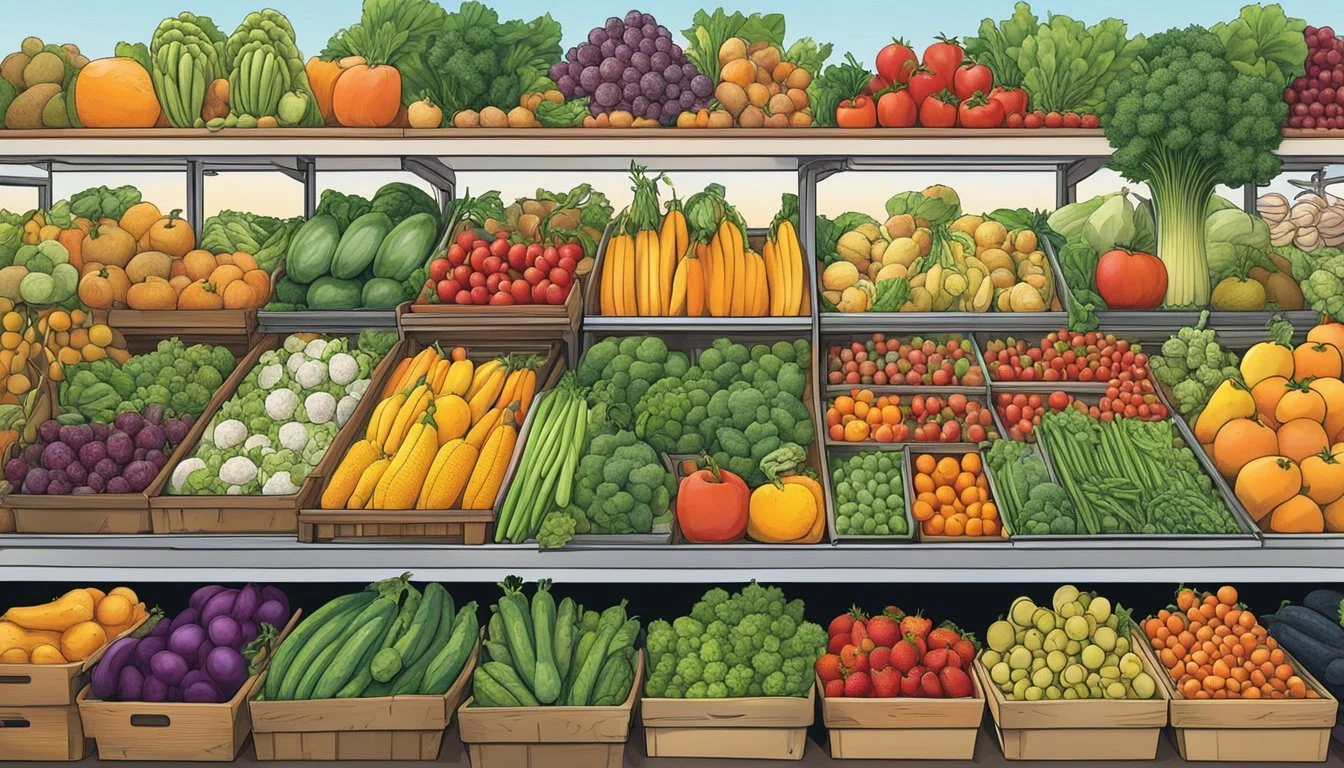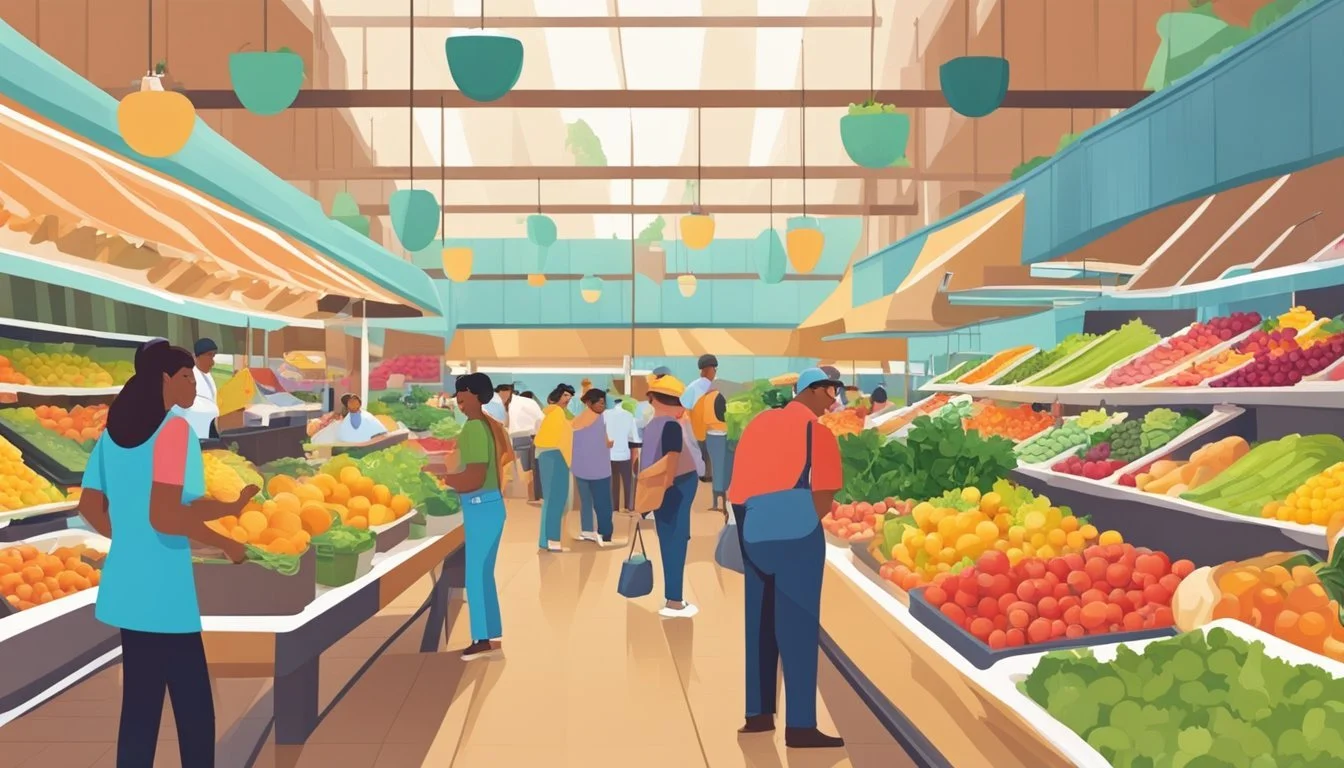5 Texas Food Markets for Fresh Produce
Top Spots for Local Greens
Finding the best places to buy fresh and locally sourced produce is a priority for many Texans. Texas food markets offer a variety of fresh, seasonal, and sustainable produce from local farms and ranches. These markets not only provide high-quality food but also promote community engagement and support local agriculture.
For those looking to explore and enjoy the freshest bounty Texas has to offer, there are several food markets worth visiting. This article highlights five notable Texas food markets that stand out for their unique offerings and community appeal.
1) Dallas Farmers Market
The Dallas Farmers Market has been a staple in the community since 1941. Visitors can enjoy seasonal produce, local eats, and handmade goods.
This market features "The Shed," an open-air pavilion where vendors sell fresh fruits, vegetables, and other local products.
In addition to produce, Dallas Farmers Market offers naturally raised meats, artisanal cheeses, and baked goods. It also has a food hall with various local restaurants.
The market is open year-round, with hours from 9 am to 5 pm on Saturdays and from 10 am to 5 pm on Sundays. Its central location provides a beautiful backdrop of the Dallas skyline.
Address: 920 S Harwood St, Dallas, TX 75201.
Phone: (214) 664-9110
Website: dallasfarmersmarket.org
2) Austin Farmers Market
Austin Farmers Market, a beloved destination for locals, is known for its robust selection and vibrant atmosphere. Visitors can expect to find a wide array of local and seasonal produce including fresh vegetables, fruits, meats, cheeses, seafood, and baked goods.
Held every Sunday from 10:00 AM to 2:00 PM, this market is a weekly favorite for many. With over 60 vendors, it offers not only fresh produce but also handcrafted items, making it a one-stop shop for everything fresh and local.
The market's location at Mueller adds to its charm, offering a community-feel that's both welcoming and engaging. The atmosphere is further enhanced by frequent live music and activities for children, making it a family-friendly outing.
For those looking to connect directly with farmers and artisans, the Austin Farmers Market provides an excellent opportunity to support local agriculture and sustainable practices.
Location: 4209 Airport Blvd, Austin, TX 78722
Website: Texas Farmers' Market at Mueller
3) Houston Urban Harvest
Houston Urban Harvest Farmers Market is a celebrated spot for local produce. Operating every Saturday from 8 a.m. to 12 p.m., it has become a cornerstone for Houston's community.
The market started in 2004 with only seven vendors. Today, it boasts a diverse array of local offerings.
Vendors include Animal Farm, Atkinson Farms, and Pat Greer’s Kitchen. All suppliers come from within 180 miles of Houston, ensuring fresh and local produce.
The market offers locally-produced vegetables, fruits, and farm products. The inclusion of ranchers and prepared food vendors adds variety.
Forty vendors operate year-round, with an additional twelve seasonal vendors. This variety supports family farms and boosts the local economy.
Address:
2752 Buffalo Speedway, Houston, TX 77027
Contact:
Phone: (713) 880-5540
Website: urbanharvest.org
4) Pearl Farmers Market
Pearl Farmers Market in San Antonio is a bustling hub for fresh, local produce. It operates every weekend, with vendors providing a diverse selection of fruits, vegetables, meats, and artisanal products. This market has earned recognition as one of the best in the country, consistently delivering quality and variety.
Visitors to Pearl Farmers Market can expect a vibrant atmosphere with live music and cooking demonstrations every Saturday. The market is not just about shopping; it’s an experience where people can learn about the food they consume directly from the producers.
Located on the grounds of the historic Pearl Brewery, the market offers modern amenities in a scenic setting. The adjacent mixed-use development features shops, restaurants, and green spaces, enhancing the overall visitor experience.
Braune Farms, CKC Farms, and Crepelandia are just a few of the regular vendors, ensuring a wide range of fresh produce and artisanal goods. Seasonal items vary, making each visit unique.
For those planning to visit, the market is hosted every Sunday from 9 a.m. to 1 p.m. Despite other events sometimes taking place on the property, vendors can consistently be found on the West lot, in front of La Gloria.
Contact Details:
Address: 303 Pearl Pkwy, San Antonio, TX 78215
Website: pearlfarmersmarket.com
Phone: (210) 212-7260
5) Texas Farmers' Market at Mueller
Texas Farmers' Market at Mueller takes place every Sunday from 10:00 AM to 2:00 PM at 2006 Philomena St., Austin, TX 78723. Rain or shine, visitors can enjoy a variety of fresh, local produce and artisan foods.
More than 60 vendors participate, offering seasonal produce, meats, cheeses, seafood, dairy, baked goods, and specialty foods. The market also features live music, kids' activities, and chef demonstrations, making it a fun and engaging event for the whole family.
The market operates under the historic Browning Hangar off Airport Blvd., providing a unique and vibrant atmosphere. Established in 2012, it has become a beloved community event.
In addition to shopping, the market runs a robust food-access program in partnership with the Sustainable Food Center, aiming to help all Texans eat locally and nutritiously. The market prides itself on being producer-only, meaning all vendors sell what they grow or produce themselves.
For more information, visit their website or follow them on Instagram and Facebook.
Health Benefits of Fresh Produce
Consuming fresh produce brings numerous health advantages. Regular intake of fruits and vegetables can significantly enhance nutritional intake and bolster the immune system.
Nutritional Value
Fresh produce is packed with essential vitamins and minerals. Vitamins A, C, and K are abundant in vegetables like spinach and kale. Vitamin A supports vision and skin health, while Vitamin C aids in collagen production and iron absorption. Vitamin K is crucial for blood clotting and bone health.
Fruits, such as oranges and berries, are excellent sources of antioxidants. These compounds help combat oxidative stress and reduce the risk of chronic diseases. Additionally, dietary fiber in fresh produce aids digestion and maintains healthy cholesterol levels.
Incorporating a variety of colorful fruits and vegetables into meals ensures a balanced diet. This diversity maximizes the range of nutrients consumed, which is vital for maintaining optimum health.
Boosting Immunity
Regular consumption of fresh produce can enhance the immune system. Citrus fruits like oranges and lemons are rich in vitamin C, known for its role in reducing the duration of common colds and enhancing immune functions.
Vegetables such as bell peppers, broccoli, and spinach also provide significant amounts of nutrients that support immune health. These include beta-carotene, which the body converts to vitamin A, necessary for maintaining the integrity of skin and mucous membranes, our first line of defense against pathogens.
Garlic and ginger possess anti-inflammatory and antiviral properties, adding another layer of protection. Consuming a diet rich in a variety of fresh produce keeps the immune system robust and ready to fend off illnesses.
How to Choose Fresh Produce
Choosing fresh produce involves understanding seasonal availability and recognizing clear signs of freshness.
Seasonal Considerations
Knowing which fruits and vegetables are in season helps ensure better taste and quality. Produce in season is often more flavorful and nutritious since it’s harvested at its natural peak.
For example, in Texas, strawberries are typically in season during late spring and early summer, while squash varieties flourish in the late summer and fall. Being familiar with these cycles can guide smarter purchasing decisions.
Farmers' markets tend to offer a wide array of seasonal produce, making them ideal places to find fresh options. A basic online search or a chat with local farmers can also provide insight into what's currently in season.
Signs of Freshness
Signs of freshness vary with each type of produce, but some general indicators can help.
For leafy greens like lettuce and spinach, look for crisp leaves that are vibrant in color and free from wilting or browning. For fruits, such as apples or berries, they should feel firm and have a rich color without any mushy spots or discolorations.
Another good practice is to smell the produce. Fresh items often have a pleasant, natural aroma. Tomatoes, for instance, should have a sweet, earthy scent near the stem.
Understanding these visual, tactile, and olfactory cues will make selecting fresh produce straightforward and effective.
Supporting Local Farmers
Buying from farmers markets directly benefits the local economy and contributes to sustainable farming practices. This section delves into the economic and environmental advantages of supporting local farmers.
Economic Impact
Purchasing produce from local farmers markets stimulates the regional economy. Money spent at these markets circulates within the community, supporting small businesses and helping to create jobs. Farmers receive a fair price for their products, eliminating the need for middlemen, which results in better profit margins for the producers.
Additionally, the presence of vibrant farmers markets can attract tourism, benefitting other local businesses such as restaurants, cafes, and shops. This economic synergy helps build a stronger, more resilient community by keeping financial resources local.
Sustainability
Local farmers markets promote environmental sustainability by reducing the carbon footprint associated with food transportation. Produce travels shorter distances compared to what is typically found in supermarkets. This not only conserves energy but also ensures fresher products for consumers.
Many local farmers employ sustainable farming techniques, such as crop rotation and reduced pesticide use, which contribute to healthier soil and ecosystems. Supporting these farmers encourages the adoption and continuation of environmentally friendly practices, which benefit both the community and the planet.
This structured approach highlights the dual importance of economic and environmental benefits when supporting local farmers, providing readers with clear and compelling reasons to shop at farmers markets in Texas.






